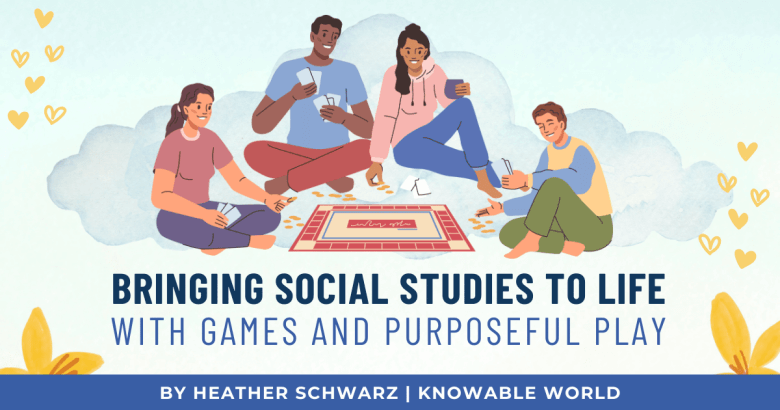By Heather Schwarz of Knowable World
Social studies is all about introducing children to the amazing world around us. It shouldn’t be confined to textbooks and worksheets!
Through purposeful play and everyday activities, we can help our children begin to understand the interconnected world we live in.
By exploring maps, looking closely at the objects in your home, and playing geography-based games, children naturally develop a deeper understanding of global connections and cultural diversity.
Bringing the World to Your Home
When we mounted a large world map on our dining room wall, we knew it was more practical than pretty - but we didn't realize it would become a centerpiece of our homeschool.
What started as a reference tool evolved into an interactive learning hub that sparks questions, conversations, and games nearly every day.
My husband and children now eagerly challenge each other with "twenty questions" about countries or compete to name nations starting with different letters of the alphabet.
They really know their way around the world map!
This simple change to our environment sparked countless learning moments. It taught me the importance of making sure the things you want your children to learn show up regularly in your daily life.
When we make geography visible and accessible, children naturally engage with it and enjoy learning about it.
The "MADE IN" Adventure
Here’s a fun and simple game that kids really love. Teach them to look for the “MADE IN” labels on their clothing, toys, food, and objects around the house.
Kids can play geography detective, finding out where the items around them came from. You can even get some small stickers to put on a laminated wall map every time they find a new country on a label.
This activity does more than teach geography—it helps children understand their personal connection to people worldwide.
That toy from Vietnam or shirt from Bangladesh becomes a tangible link to another part of the world, sparking curiosity about the lives of the people who made it.
From Market to Map
The grocery store offers another rich opportunity for geographic exploration. Planning meals around different countries turns shopping into a cultural expedition.
Let your kids help you plan a meal where you "travel" through multiple countries, combining ingredients from various nations. This activity naturally leads to discussions about issues like climate, agriculture, and cultural food traditions.
Pairing these culinary adventures with books about children from different cultures, such as DK's "Children Just Like Me", helps build meaningful connections between geography and human experience.
Children begin to understand that behind every imported ingredient there is a story about real people and their daily lives.
Games and Puzzles with Purpose
Traditional learning tools like puzzles and board games are also great tools for geography education.
World map puzzles help children grasp spatial relationships and recognize country shapes, while games like "Ticket to Ride" introduce geography through engaging gameplay.
These activities build geographic literacy while developing problem-solving skills and strategic thinking.
Digital Exploration Through Virtual Worlds
Technology offers unique opportunities for immersive historical and geographical learning. Virtual worlds and educational games can transport children to different times and places, offering rich, detailed environments to explore.
One of my favorites has been Assassin's Creed: Odyssey, which includes an educational mode so you can freely explore ancient Greece, complete with guided tours and historical information.
These virtual environments make history tangible and interactive in ways traditional resources cannot.
The key is to approach these digital tools thoughtfully, using them as springboards for deeper learning.
When our family explores virtual ancient Greece, we often pause to look up additional information about interesting locations or historical figures we encounter.
This combination of immersive experience and guided research creates lasting connections with historical content.
Cultural Awareness Through Play
As we explore different cultures through play and activities, it's essential to approach these learning opportunities with respect and cultural sensitivity.
Rather than treating other cultures as exotic or entertaining, we can help our children understand and appreciate the depth and significance of different cultural practices and perspectives.
When exploring foods from different cultures, for instance, take time to learn about the cultural significance of various dishes.
When playing games based on different cultures or historical periods, discuss the real people and societies represented. This mindful approach helps children develop both cultural awareness and empathy.
Understanding Purposeful Play
Purposeful play goes beyond simply making learning fun—it's about creating meaningful interactions that naturally lead to discovery and understanding. You can think about:
- Setting up environments that pique curiosity and invite exploration
- Encouraging children to ask questions and helping them search for answers
- Creating connections between play activities and real-world understanding
- Allowing time for reflection and discussion about what's been learned
The most effective purposeful play often emerges from real-life contexts, like our "MADE IN" game or mealtime map games.
These activities work because they connect learning to children's daily experiences, our values as parents, and their genuine interests.
Understanding Our Connected World
The goal of these activities extends beyond memorizing capitals or borders. Through purposeful play, children develop an understanding of our interconnected world.
When they recognize products from different countries in their own home, plan international meals, or trace railway routes across continents in board games, they're building a framework for understanding global relationships and cultural diversity.
These everyday learning opportunities help children see themselves as part of a larger global community. By making geography tangible and relevant to their daily lives, we nurture their natural curiosity about the world and its people.
Remember that the most effective learning often happens naturally through play and daily activities.
By creating an environment rich in geographic awareness and encouraging exploration through games and activities, we help our children develop a deeper understanding of the world they live in—one discovery at a time.

Geography Activity Bundle! 100 pages of activities for mastering world geography! Includes 4 complete game sets with multiple play options, map and flag activities, crosswords, and word searches. Perfect for homeschool families with elementary/middle school students. $27.00
Read More!
- Log in to post comments






